





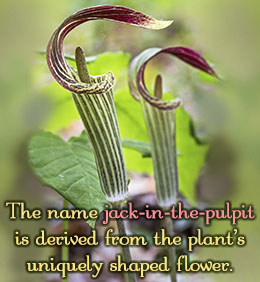 Sex Changing Plant!The jack-in-the-pulpit has a long lifespan; the plant changes its gender several times, year after year. Change of sex is determined by factors like corm size and availability of nutrients.Jack-in-the-pulpit―the plant with a unique name has an equally unique flower. It has a long, finger-shaped spadix located inside a cylindrical spathe that has a hooded tip. If you go by the name, jack represents the spadix, and the pouch-like spathe denotes the pulpit.
Sex Changing Plant!The jack-in-the-pulpit has a long lifespan; the plant changes its gender several times, year after year. Change of sex is determined by factors like corm size and availability of nutrients.Jack-in-the-pulpit―the plant with a unique name has an equally unique flower. It has a long, finger-shaped spadix located inside a cylindrical spathe that has a hooded tip. If you go by the name, jack represents the spadix, and the pouch-like spathe denotes the pulpit. 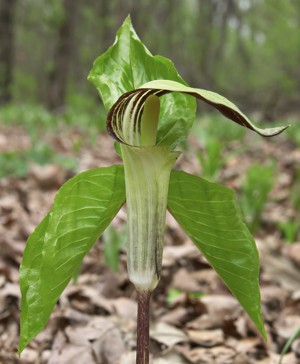 The leaf and flower of jack-in-the-pulpit plantThe flower of this plant has a peculiar structure. It has a long spadix covered by a leaf-like spathe. The flower can be whitish-green, green, or purple, and the spathe can be plain, mottled, or striped. The tip of the spathe bends over the spadix, like a hood, partially covering the open top. The spadix can be eight to ten centimeters long, and the flowers are located on its lower end. Blood-red berries are formed on the thickened, club-shaped spadix. Each berry contains one to five tan-colored seeds. Given below are some pictures of jack-in-the-pulpit flowers.
The leaf and flower of jack-in-the-pulpit plantThe flower of this plant has a peculiar structure. It has a long spadix covered by a leaf-like spathe. The flower can be whitish-green, green, or purple, and the spathe can be plain, mottled, or striped. The tip of the spathe bends over the spadix, like a hood, partially covering the open top. The spadix can be eight to ten centimeters long, and the flowers are located on its lower end. Blood-red berries are formed on the thickened, club-shaped spadix. Each berry contains one to five tan-colored seeds. Given below are some pictures of jack-in-the-pulpit flowers.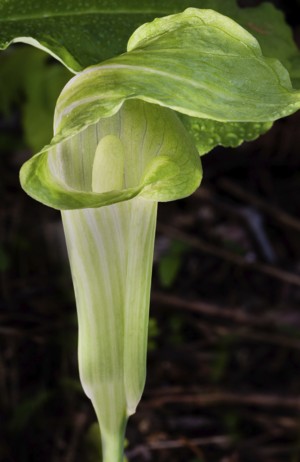
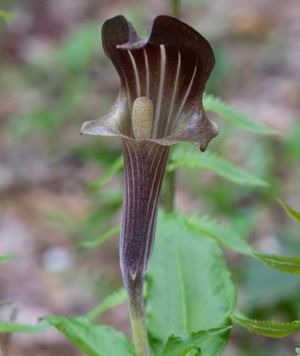
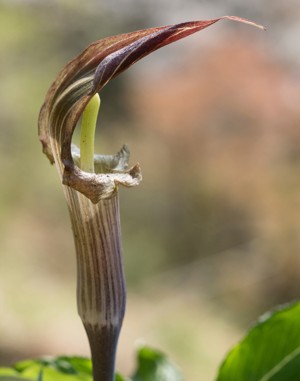 Flowers of jack-in-the-pulpit plantsJack-in-the-pulpit - Life CycleReproduction in jack-in-the-pulpit plants can be either sexual or asexual. New plants may develop asexually, from the mature corms that produce cormlets. In sexual reproduction, pollinators carry pollen from male flowers to female flowers, thereby fertilizing the latter that develop berries containing seeds. Bisexual or Unisexual?It has been suggested that male and female flowers develop on the same plant, but only one type predominates. This is said to be nature's way of preventing self-fertilization. Jack-in-the-pulpit is one among the few sex changing plants which can change their gender many times throughout their lifespan. Some of these plants may live for more than 100 years if conditions are favorable. While male plants do not require much resources, female plants need stored resources for flowering and fruit production.
Flowers of jack-in-the-pulpit plantsJack-in-the-pulpit - Life CycleReproduction in jack-in-the-pulpit plants can be either sexual or asexual. New plants may develop asexually, from the mature corms that produce cormlets. In sexual reproduction, pollinators carry pollen from male flowers to female flowers, thereby fertilizing the latter that develop berries containing seeds. Bisexual or Unisexual?It has been suggested that male and female flowers develop on the same plant, but only one type predominates. This is said to be nature's way of preventing self-fertilization. Jack-in-the-pulpit is one among the few sex changing plants which can change their gender many times throughout their lifespan. Some of these plants may live for more than 100 years if conditions are favorable. While male plants do not require much resources, female plants need stored resources for flowering and fruit production. 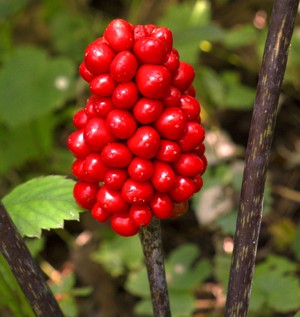 Jack-in-the-pulpit berriesPollinationJack-in-the-pulpit flowers emit a faint fungal smell, which attracts fungal gnats. These insects fly into the cylindrical spathe and get trapped. If it happens to be a male flower, the insects get coated with pollen particles, as they search frantically for a way out. The male flower has a small opening at its base, through which the insects can escape. If these insects enter a female flower, they will get trapped once again; and in their efforts to escape, they drop the pollen particle on female flowers located at the base of the spadix. However, they will remain trapped and die eventually, as there is no exit at the base of the flower. The bloom period is from mid to late spring. However, the flowers remain attractive for a long time, and this is one of the reasons for the popularity of jack-in-the-pulpit as an ornamental plant. If fertilized, the flower produces berries that are green in color. They turn blood red as they get ripe. If properly dispersed, the seeds may produce new plants. Is the Plant Edible for Humans?Though jack-in-the-pulpit berries are attractive, they are not edible. It is advisable not to ingest any part of the plant, as it contains oxalic acid in considerable amounts. Such ingestion may lead to swelling of the throat and mouth, along with a strong burning sensation. Severe gastric distress may also develop. However, some people use the corms of these plants as food. They remove the toxins through roasting, drying, or leaching. This plant is toxic for animals like cattle, sheep, goats, pigs, cats, and dogs. How to Grow Jack-in-the-pulpit PlantsThe jack-in-the-pulpit is often grown for its peculiar flower. In their natural habitat, these plants are seen growing on forest floors with fertile, moist soil. So, they are ideal as shade plants. You can propagate them using their seeds or cormlets. Collect seeds from ripe berries and remove the pulp, before placing them in between layers of moist sphagnum moss. Refrigerate the seeds for at least two to three months, before you start them indoors. Transplant the seedlings to an outdoor location during early spring. You may also plant the seeds soon after you remove them from the berries. Dig holes with a depth of half an inch and place the seeds (one in each hole) inside them. Cover with loose, moist soil. Make sure to grow these plants in locations with enough shade. You may also separate the cormlets during late fall, and grow them into new plants. Wear gloves while handling the berries and corms, to avoid skin irritation.
Jack-in-the-pulpit berriesPollinationJack-in-the-pulpit flowers emit a faint fungal smell, which attracts fungal gnats. These insects fly into the cylindrical spathe and get trapped. If it happens to be a male flower, the insects get coated with pollen particles, as they search frantically for a way out. The male flower has a small opening at its base, through which the insects can escape. If these insects enter a female flower, they will get trapped once again; and in their efforts to escape, they drop the pollen particle on female flowers located at the base of the spadix. However, they will remain trapped and die eventually, as there is no exit at the base of the flower. The bloom period is from mid to late spring. However, the flowers remain attractive for a long time, and this is one of the reasons for the popularity of jack-in-the-pulpit as an ornamental plant. If fertilized, the flower produces berries that are green in color. They turn blood red as they get ripe. If properly dispersed, the seeds may produce new plants. Is the Plant Edible for Humans?Though jack-in-the-pulpit berries are attractive, they are not edible. It is advisable not to ingest any part of the plant, as it contains oxalic acid in considerable amounts. Such ingestion may lead to swelling of the throat and mouth, along with a strong burning sensation. Severe gastric distress may also develop. However, some people use the corms of these plants as food. They remove the toxins through roasting, drying, or leaching. This plant is toxic for animals like cattle, sheep, goats, pigs, cats, and dogs. How to Grow Jack-in-the-pulpit PlantsThe jack-in-the-pulpit is often grown for its peculiar flower. In their natural habitat, these plants are seen growing on forest floors with fertile, moist soil. So, they are ideal as shade plants. You can propagate them using their seeds or cormlets. Collect seeds from ripe berries and remove the pulp, before placing them in between layers of moist sphagnum moss. Refrigerate the seeds for at least two to three months, before you start them indoors. Transplant the seedlings to an outdoor location during early spring. You may also plant the seeds soon after you remove them from the berries. Dig holes with a depth of half an inch and place the seeds (one in each hole) inside them. Cover with loose, moist soil. Make sure to grow these plants in locations with enough shade. You may also separate the cormlets during late fall, and grow them into new plants. Wear gloves while handling the berries and corms, to avoid skin irritation.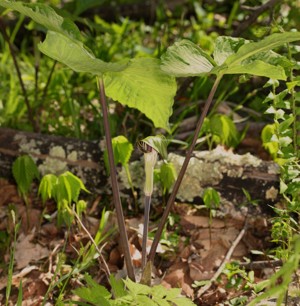 Jack-in-the-pulpit plantIn short, grow jack-in-the-pulpits in moist, fertile soil that is enriched with compost. Organic mulch can be used to retain moisture in the soil. Make sure that you replace the mulch year after year. Though the plant is highly resistant to diseases and pests, slug attacks are very common. You can get rid of them by using traps or baits. If you manage to trap live slugs, put them in soap water. To conclude, jack-in-the-pulpits are wild plants with some interesting features. They are not fussy and can tolerate different soil conditions. However, shade and moist soil are the most important requirements of this plant. It takes more than three years for the plant to get established and start flowering. They can be grown in USDA zones 3 to 9.
Jack-in-the-pulpit plantIn short, grow jack-in-the-pulpits in moist, fertile soil that is enriched with compost. Organic mulch can be used to retain moisture in the soil. Make sure that you replace the mulch year after year. Though the plant is highly resistant to diseases and pests, slug attacks are very common. You can get rid of them by using traps or baits. If you manage to trap live slugs, put them in soap water. To conclude, jack-in-the-pulpits are wild plants with some interesting features. They are not fussy and can tolerate different soil conditions. However, shade and moist soil are the most important requirements of this plant. It takes more than three years for the plant to get established and start flowering. They can be grown in USDA zones 3 to 9.
Copyright © www.100flowers.win Botanic Garden All Rights Reserved